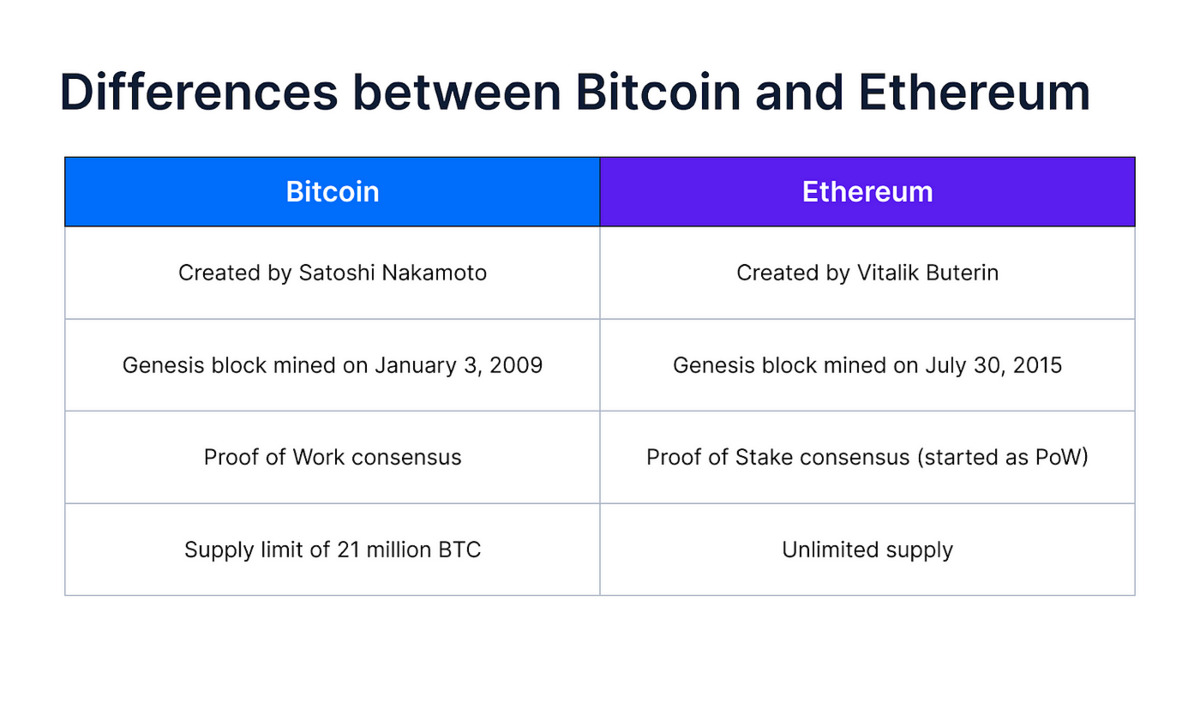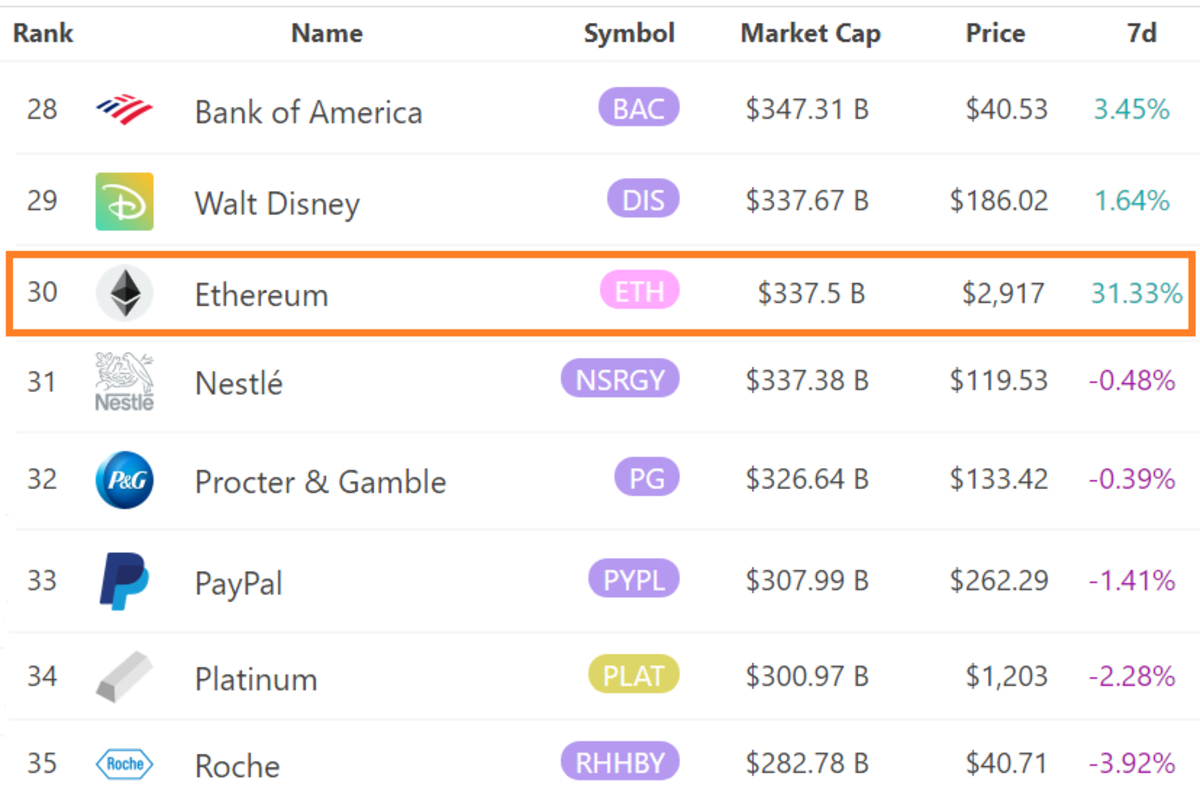Introduction
The world of cryptocurrency has seen immense growth and potential in recent years, with Bitcoin and Ethereum being two of the most prominent players in this rapidly evolving landscape. Bitcoin, the pioneering cryptocurrency, has captured mainstream attention with its remarkable price surge, raising speculation about whether it will reach the astonishing target of $1 million.
As Bitcoin’s market dominance continues to solidify, it raises questions about the impact its ascent would have on other cryptocurrencies. Ethereum, often regarded as the second-largest cryptocurrency, has a complex and intertwined relationship with Bitcoin. In this article, we will explore the potential scenarios for Ethereum if Bitcoin were to hit the $1 million mark.
Before diving into these scenarios, it is essential to understand the current state of both Bitcoin and Ethereum. Bitcoin, founded in 2009, introduced the concept of decentralized digital currency, utilizing blockchain technology to revolutionize how transactions are verified and recorded. Ethereum, launched in 2015, expanded upon this idea by adding smart contract functionality, allowing developers to build decentralized applications or dApps.
Bitcoin’s market dominance has been unchallenged for years. Its limited supply, a maximum of 21 million coins, and growing demand have contributed to its significant price appreciation over time. While Bitcoin remains the go-to cryptocurrency for institutional and retail investors, Ethereum has carved out its own niche ecosystem with its focus on decentralization and smart contracts.
The possibility of Bitcoin reaching the $1 million mark comes from the belief that its scarcity (due to its capped supply) combined with increased adoption and institutional interest could drive demand to unprecedented levels. However, it’s important to note that this is purely speculative, and the crypto market is highly volatile and unpredictable.
The Current State of Bitcoin and Ethereum
Before delving into the potential scenarios for Ethereum if Bitcoin were to reach $1 million, it is crucial to assess and understand their current states in the cryptocurrency market.
Bitcoin, often referred to as digital gold, has witnessed a surge in popularity and adoption in recent years. With a market capitalization surpassing $1 trillion, Bitcoin has become a household name and a symbol of the cryptocurrency revolution. Its value has experienced significant fluctuations, accompanied by periods of immense growth and abrupt declines. However, Bitcoin has managed to maintain its position as the dominant force in the crypto space.
Ethereum, on the other hand, is often regarded as the blockchain platform that revolutionized the industry with its smart contract functionality. The Ethereum platform allows developers to build decentralized applications (dApps) and execute programmable agreements without the need for intermediaries. As a result, Ethereum has gained significant attention and attracted a vibrant community of developers and entrepreneurs.
In terms of market capitalization, Ethereum currently stands as the second-largest cryptocurrency, trailing behind Bitcoin. With its lower price per unit compared to Bitcoin, Ethereum offers a more affordable entry point for investors, leading to increased accessibility and participation in the market.
Bitcoin and Ethereum represent two distinct ideologies within the cryptocurrency world. Bitcoin emphasizes its function as digital gold, aiming to store value and serve as a hedge against traditional financial systems’ shortcomings. Meanwhile, Ethereum focuses on fostering innovation through its smart contract capabilities, aiming to revolutionize various industries, including finance, supply chain management, and decentralized finance (DeFi).
As the crypto market continues to evolve, both Bitcoin and Ethereum face unique challenges and opportunities. Efforts are being made to address scaling issues and optimize transaction speed, fueling research and development in areas such as layer 2 solutions and Ethereum 2.0’s shift to a proof-of-stake consensus mechanism.
Furthermore, institutional adoption of Bitcoin and Ethereum has witnessed a significant increase in recent years. Several well-known companies, including Tesla and Square, have added Bitcoin to their company balance sheets, while major financial institutions have shown interest in Ethereum’s potential to transform traditional finance.
It’s crucial to note that both Bitcoin and Ethereum operate in a highly volatile market, where price movements can occur rapidly. Investors should exercise caution and perform thorough research before engaging in any cryptocurrency-related activities.
Bitcoin’s Potential for Hitting $1 Million
Speculation about Bitcoin potentially reaching a staggering price of $1 million has been a topic of discussion among investors and enthusiasts. While this projection may seem unrealistic to some, it’s important to examine the factors that could contribute to such a significant increase in Bitcoin’s value.
One of the primary drivers behind Bitcoin’s potential for hitting $1 million is its capped supply. Unlike traditional fiat currencies, where central banks can increase the money supply at will, Bitcoin has a maximum supply of 21 million coins. This scarcity increases its value proposition and creates an environment where demand can potentially outstrip supply.
Furthermore, increased institutional adoption and mainstream acceptance of Bitcoin have fueled growing interest in the cryptocurrency. Companies like Tesla, Square, and MicroStrategy have allocated significant portions of their balance sheets to Bitcoin, signaling confidence in its long-term potential. Additionally, major financial institutions, such as PayPal and Visa, have started offering services that enable users to buy, sell, and hold Bitcoin.
The current macroeconomic climate, characterized by unprecedented fiscal stimulus, low-interest rates, and concerns about potential inflation, has also played a role in driving interest towards Bitcoin. Many investors view Bitcoin as a hedge against potential fiat currency devaluation and a store of value similar to gold. This perception has contributed to its increasing adoption as a digital alternative to traditional assets.
Moreover, the growing recognition of Bitcoin as a legitimate asset class by regulatory authorities and governments around the world has provided a level of legitimacy to the cryptocurrency. This recognition has led to increased investor confidence and reduced regulatory uncertainties, making Bitcoin more attractive to institutional and retail investors alike.
However, it’s essential to acknowledge the inherent volatility of the cryptocurrency market. Bitcoin has experienced significant price fluctuations in the past, and future price movements can be equally unpredictable. Factors such as market sentiment, regulatory developments, technological advancements, and macroeconomic conditions can all impact Bitcoin’s price trajectory.
Ultimately, predicting whether Bitcoin will reach $1 million is challenging, and it should be approached with caution. While the potential for such an astronomical increase exists, investors should carefully assess their risk tolerance and consider diversifying their investment portfolios to mitigate potential downsides.
The Factors Influencing Bitcoin’s Price Increase
Bitcoin’s price is influenced by a wide range of factors, ranging from market dynamics and investor sentiment to macroeconomic conditions. Understanding these factors is crucial in analyzing the potential for Bitcoin’s price to increase.
1. Supply and Demand: Bitcoin’s capped supply of 21 million coins creates scarcity, which, combined with growing demand, can drive up its price. The increasing institutional adoption of Bitcoin, along with mainstream acceptance, has contributed to a surge in demand.
2. Institutional Adoption: The entry of large institutions into the cryptocurrency space has had a profound impact on Bitcoin’s price. Companies like Tesla, Square, and MicroStrategy allocating significant portions of their balance sheets to Bitcoin have brought both credibility and increased liquidity to the market.
3. Market Sentiment: The sentiment among investors and traders plays a significant role in determining Bitcoin’s price. Positive news, such as regulatory advancements or successful Bitcoin-related projects, can boost sentiment and drive prices higher. Conversely, negative news or market uncertainties can lead to price downturns.
4. Regulatory Developments: The regulatory environment surrounding cryptocurrencies can greatly influence Bitcoin’s price. Clarity and favorable regulations can provide confidence to investors, while stricter regulations or bans can have a negative impact on sentiment and price stability.
5. Macroeconomic Conditions: Bitcoin is often seen as a hedge against traditional financial systems and inflation concerns. Factors such as fiscal stimulus measures, low-interest rates, and uncertainties in the global economy can drive investors toward Bitcoin as a store of value, potentially leading to price increases.
6. Technological Advancements: Technological advancements and improvements in the underlying blockchain technology can have a positive impact on Bitcoin’s price. Enhancements in scalability, speed, and security can attract more users and increase overall demand.
7. Market Manipulation: As with any financial market, Bitcoin is vulnerable to manipulation by large traders or entities. Market manipulation can artificially inflate or deflate prices, making it essential for investors to be aware of potential risks and engage with reputable platforms.
8. Media and Influencers: The media and influential figures can significantly impact Bitcoin’s price through their coverage and statements. Positive or negative sentiment generated by media coverage or influential figures can sway investor sentiment and affect short-term price movements.
9. Technological Risks: Bitcoin faces inherent risks associated with its technology, such as potential security breaches or vulnerabilities. While the blockchain technology that underpins Bitcoin is considered robust, new risks and challenges may emerge that could impact its price.
Understanding these factors can provide insights into the potential drivers of Bitcoin’s price increase. However, it’s important to note that the cryptocurrency market is highly volatile and unpredictable, and multiple factors can interact to influence prices at any given time.
Ethereum’s Relationship with Bitcoin’s Price
Ethereum, often seen as the “little brother” of Bitcoin, shares a complex and intertwined relationship with the pioneer cryptocurrency. While Ethereum has its own unique value proposition and use cases, the price of Ethereum is often influenced by movements in the price of Bitcoin. Understanding this relationship is essential in analyzing the potential scenarios for Ethereum if Bitcoin were to reach $1 million.
One of the primary reasons for the correlation between Ethereum and Bitcoin’s price is investor sentiment. Bitcoin is often regarded as a bellwether for the overall cryptocurrency market. When Bitcoin experiences significant price movements, it tends to have a spillover effect on other cryptocurrencies, including Ethereum. Positive sentiment and a rising Bitcoin price can create a wave of optimism that lifts the entire market, causing Ethereum’s price to follow suit.
Additionally, Bitcoin’s dominance in terms of market capitalization and liquidity affects Ethereum’s price. Bitcoin’s market movements can lead to increased trading volume and overall market activity. Traders and investors who are actively engaged in Bitcoin may also have exposure to Ethereum, leading to correlated price movements between the two cryptocurrencies.
Another factor contributing to the relationship between Bitcoin and Ethereum is the Ethereum network’s reliance on Bitcoin as a base currency. Many decentralized exchanges (DEXs) and initial coin offerings (ICOs) use Bitcoin as the primary trading pair or fundraising currency. As a result, changes in Bitcoin’s price can have a direct impact on Ethereum’s ecosystem, influencing demand and trading activity within the Ethereum network.
However, it’s important to note that Ethereum also has its own unique characteristics and fundamentals that can drive its price independently of Bitcoin. Ethereum’s smart contract capabilities and its role as a platform for decentralized applications (dApps) give it a distinct value proposition that is separate from Bitcoin’s store of value narrative.
Additionally, Ethereum’s vibrant ecosystem, with numerous projects and tokens built on top of its blockchain, means that Ethereum’s price can be influenced by factors specific to its own network. These factors include the adoption of Ethereum technology in various industries, the development of new dApps, and the growth of decentralized finance (DeFi) applications.
As the cryptocurrency market continues to mature, Ethereum has the potential to decouple from Bitcoin to a certain extent. This means that Ethereum’s price may start to move independently based on its own fundamentals and market dynamics. However, in the current state of the market, Bitcoin’s price movements remain an essential factor to consider when analyzing Ethereum’s price outlook and potential scenarios.
Potential Scenarios for Ethereum if Bitcoin Hits $1 Million
If Bitcoin were to reach an astounding price of $1 million, it would undoubtedly have a significant impact on the entire cryptocurrency market, including Ethereum. While the future is uncertain, several potential scenarios can be envisaged based on the dynamics between the two cryptocurrencies.
Scenario 1: Ethereum Follows Bitcoin’s Footsteps
In this scenario, Ethereum closely mirrors Bitcoin’s price trajectory. As Bitcoin’s price skyrockets, the overall positive sentiment and increased attention in the market could create a halo effect that boosts Ethereum’s price as well. Investors, eager to capitalize on the crypto market’s upward momentum, may pour funds into Ethereum, leading to a surge in demand and price appreciation for the second-largest cryptocurrency.
Scenario 2: Ethereum Experiences Independent Growth
In this scenario, Ethereum’s price decouples to some extent from Bitcoin’s price movement. Ethereum’s unique value proposition as a platform for decentralized applications (dApps), smart contracts, and the broader adoption of blockchain technology could drive its growth independently. Positive developments in the Ethereum ecosystem, such as the launch of Ethereum 2.0 or the widespread adoption of DeFi applications, may attract investors and fuel the demand for Ethereum, resulting in a surge in its price.
Scenario 3: Ethereum Faces Challenges in the Wake of Bitcoin’s Rise
While Bitcoin’s rise to $1 million may seem beneficial for the entire cryptocurrency market, Ethereum could face challenges. A skyrocketing Bitcoin price might overshadow Ethereum’s spotlight, diverting investor attention and resources away from the second-largest cryptocurrency. Additionally, if Bitcoin’s rise is accompanied by increased market volatility, it could lead to a risk-off sentiment, causing investors to shy away from more speculative assets like Ethereum.
It’s important to note that these scenarios are speculative in nature, and numerous other factors and dynamics could come into play. The level of correlation between Bitcoin and Ethereum, as well as market sentiment, institutional adoption, and regulatory developments, will all influence Ethereum’s trajectory if Bitcoin were to hit $1 million.
Moreover, the cryptocurrency market is highly volatile, and sudden market shifts or unforeseen events could disrupt any projected scenarios. It is crucial for investors to assess their risk tolerance and conduct thorough research before making any investment decisions in the cryptocurrency space.
Scenario 1: Ethereum Follows Bitcoin’s Footsteps
In this scenario, Ethereum closely mirrors Bitcoin’s price trajectory as the pioneer cryptocurrency reaches a remarkable $1 million. As Bitcoin’s price surges, the overall positive sentiment and increasing interest in the cryptocurrency market create a halo effect that spills over to Ethereum.
Investors, eager to capitalize on the upward momentum in the market, view Ethereum as an attractive investment opportunity. They recognize that if Bitcoin can achieve such a remarkable milestone, Ethereum, as the second-largest cryptocurrency, stands to benefit as well.
The surge in demand for Ethereum leads to a surge in its price as well. Traders and investors see the potential for Ethereum to experience similar price appreciation, driven by the same factors that propelled Bitcoin’s rise. The scarcity of Ethereum, similar to Bitcoin, creates an environment where demand can outstrip supply, further contributing to the price increase.
Moreover, Ethereum’s unique value proposition as a platform for decentralized applications (dApps) and smart contracts continues to attract developers and entrepreneurs. This increases the adoption and utility of the Ethereum network, further contributing to the positive sentiment surrounding the cryptocurrency.
Institutional investors, seeing the success of Bitcoin and intrigued by the potential of Ethereum, allocate funds towards the second-largest cryptocurrency. Their participation not only increases liquidity in the Ethereum market but also instills confidence in the broader investor community.
The scenario of Ethereum closely following Bitcoin’s footsteps presents a bullish outlook for the cryptocurrency. It implies that Ethereum can ride the wave of Bitcoin’s massive price increase, benefiting from the market’s overall positive sentiment and increased attention.
However, it’s important to note that while Ethereum may follow Bitcoin’s price trajectory, it still retains its unique characteristics and value proposition. Ethereum’s emphasis on decentralization, smart contracts, and the growth of decentralized finance (DeFi) applications further differentiate it from Bitcoin. These factors can contribute to Ethereum’s growth and provide additional catalysts for its price appreciation, beyond simply mirroring Bitcoin’s success.
Investors considering this scenario should be mindful of the inherent volatility in the cryptocurrency market. Market conditions can change rapidly, and it’s essential to conduct thorough research and assess risk tolerance before making investment decisions.
Scenario 2: Ethereum Experiences Independent Growth
In this scenario, Ethereum’s price decouples to some extent from Bitcoin’s price movement as Bitcoin hits the remarkable $1 million milestone. Ethereum’s unique value proposition and its role as a platform for decentralized applications (dApps) and smart contracts drive its growth independently.
While Ethereum’s price may still be influenced by overall positive sentiment in the market due to Bitcoin’s success, the focus shifts to Ethereum’s own fundamentals and market dynamics. Positive developments within the Ethereum ecosystem play a crucial role in driving independent growth for the cryptocurrency.
The launch of Ethereum 2.0, with its transition to a proof-of-stake consensus mechanism and increased scalability, could be a game-changer for the Ethereum network. This scalability improvement has the potential to attract more users and developers to build on the Ethereum platform, leading to increased adoption and utility.
Furthermore, the growth of decentralized finance (DeFi) applications built on Ethereum has been a significant driver of its success. With a thriving ecosystem of lending, trading, and yield farming protocols, Ethereum’s role in powering DeFi continues to gain recognition. As DeFi expands and matures, it brings more users and value into the Ethereum network, independently fueling its growth.
The broader adoption of Ethereum technology beyond the cryptocurrency space holds promise for its price appreciation. Ethereum’s capabilities in automating agreements, providing transparency, and eliminating intermediaries have garnered interest from various industries such as supply chain management, identity verification, and even traditional finance. If Ethereum’s technology gains traction in these sectors, it could unlock new sources of demand and drive its independent growth.
Investor confidence and market sentiment play key roles in this scenario. Positive developments within the Ethereum ecosystem, such as successful dApps, partnerships, and regulatory advancements, can create a self-reinforcing cycle of increased demand. Investors who recognize Ethereum’s unique value proposition and growth potential may allocate funds directly into Ethereum, further fueling its independent growth.
However, it’s important to acknowledge that while Ethereum may experience independent growth, it is still influenced by overall market conditions and sentiment. Significant price movements in Bitcoin or other major cryptocurrencies can have indirect effects on Ethereum’s price. Careful consideration of market dynamics and thorough research are essential for investors interested in this scenario.
Scenario 3: Ethereum Faces Challenges in the Wake of Bitcoin’s Rise
In this scenario, as Bitcoin reaches the remarkable $1 million mark, Ethereum faces challenges and potential obstacles in its own growth trajectory. While the surge in Bitcoin’s price creates an overall positive sentiment in the cryptocurrency market, Ethereum may struggle to maintain the same level of attention and investor interest.
Bitcoin’s meteoric rise overshadows the spotlight on other cryptocurrencies, including Ethereum. The majority of media coverage and investor focus is directed towards Bitcoin, leaving Ethereum with less visibility and potentially diverting resources away from the second-largest cryptocurrency.
Furthermore, Bitcoin’s extraordinary price increase might lead to increased market volatility and risk-off sentiment. Investors, cautious about speculative assets, may become hesitant to invest in higher-risk cryptocurrencies like Ethereum. They may prefer to seek stability in more established assets or assets perceived as safer, undermining the demand for Ethereum and potentially affecting its price negatively.
Additionally, if Bitcoin’s rise is accompanied by regulatory challenges or clampdowns, it could spill over into the broader cryptocurrency market, including Ethereum. Regulatory actions against Bitcoin may create uncertainty and a negative perception of the entire crypto space, deterring investors from engaging with Ethereum as well.
Moreover, the dynamics between Bitcoin and Ethereum can sometimes be complementary but also competitive. While Ethereum has its unique value proposition as a platform for dApps and smart contracts, it still competes for attention and resources in the broader cryptocurrency market. If Bitcoin’s price surge captures a significant portion of market attention, it may limit the opportunities for Ethereum to shine in its own right.
However, it’s important to emphasize that Ethereum’s underlying fundamentals and unique value proposition still exist, even in the face of such challenges. The continued growth of the decentralized finance (DeFi) sector, the upcoming Ethereum 2.0 upgrade, and the expanding network of dApps contribute to Ethereum’s foundational strength. These factors may help Ethereum weather the challenges and position itself for future growth, even if it faces hurdles in the wake of Bitcoin’s rise.
Investors looking at this scenario should exercise caution and conduct thorough research. Assessing Ethereum’s long-term potential, evaluating its ecosystem’s developments, and closely monitoring market dynamics are essential steps to navigate the challenges and uncertainties Ethereum may face.
Comparing Ethereum’s Potential to Other Cryptocurrencies
As the cryptocurrency market continues to evolve and mature, Ethereum stands as one of the most prominent players alongside a diverse range of other cryptocurrencies. While each cryptocurrency has its unique characteristics and use cases, comparing Ethereum’s potential to other cryptocurrencies provides valuable insights into its competitive landscape.
Bitcoin, as the pioneering cryptocurrency, remains the dominant force in the market with its massive market capitalization and widespread recognition. Bitcoin’s primary value proposition lies in its store of value and position as digital gold. It has established itself as a well-established and trusted asset, particularly favored by institutional investors. However, Bitcoin’s limited functionality and focus on store of value sets it apart from Ethereum, which offers smart contract capabilities and the building blocks for decentralized applications (dApps).
Other competitors, such as Ripple (XRP), Bitcoin Cash (BCH), and Litecoin (LTC), have each carved out their niche within the cryptocurrency landscape. Ripple focuses on facilitating low-cost international money transfers, while Bitcoin Cash and Litecoin aim to improve upon Bitcoin’s scalability and transaction speeds. While these cryptocurrencies have their respective strengths, Ethereum retains a broader range of use cases and has garnered a more extensive developer community.
When it comes to smart contracts and dApps, Ethereum’s main competitor is Binance Smart Chain (BSC). Binance Smart Chain offers compatibility with Ethereum’s tooling and ecosystem, along with lower transaction fees. However, Ethereum’s long-established network effect, robust developer community, and higher level of decentralization remain significant advantages that contribute to its potential and adoption.
Another important aspect to consider is the emerging sector of decentralized finance (DeFi). Ethereum has emerged as the go-to platform for building DeFi applications and protocols. Its well-established infrastructure, composability, and vibrant ecosystem have attracted significant investment and innovation. While other platforms, such as Cardano (ADA) and Polkadot (DOT), offer similar functionalities, Ethereum’s first-mover advantage and network effects continue to provide a competitive edge.
Looking beyond functionality, Ethereum’s potential is also reflected in its scalability solutions and upcoming upgrades. Ethereum 2.0, set to be fully rolled out in the near future, aims to address scalability issues while transitioning from a proof-of-work to a proof-of-stake consensus mechanism. These improvements can enhance Ethereum’s transaction speeds and reduce fees, providing a more efficient and user-friendly experience.
It’s important to note that the cryptocurrency market is highly dynamic and subject to rapid change. The potential for innovative projects and new technology to disrupt the industry remains ever-present. However, with its established market position, robust ecosystem, and ongoing developments, Ethereum continues to hold significant potential when compared to other cryptocurrencies.
Conclusion
The cryptocurrency market, led by Bitcoin and Ethereum, continues to captivate the attention of investors and enthusiasts alike. While the speculation about Bitcoin reaching the extraordinary price of $1 million raises questions about Ethereum’s potential, its relationship with Bitcoin remains complex.
In assessing potential scenarios, it is clear that Ethereum’s fate is intricately tied to Bitcoin’s price movements, but it is not solely dependent on them. The three presented scenarios demonstrate the range of possibilities for Ethereum if Bitcoin were to reach $1 million.
In Scenario 1, Ethereum closely follows Bitcoin’s footsteps, benefitting from increased investor interest and overall positive market sentiment. Scenario 2 sees Ethereum break away from Bitcoin, experiencing independent growth driven by its unique value proposition, including smart contracts and the burgeoning DeFi ecosystem. In Scenario 3, Ethereum faces challenges as Bitcoin’s rise diverts attention and introduces market volatility.
Comparing Ethereum to other cryptocurrencies highlights its competitive strengths, such as its established developer community, robust infrastructure, and dominance in the DeFi space. However, it is important to remain attentive to emerging technologies and changing market dynamics that could disrupt the landscape.
As investors navigate the cryptocurrency market, careful consideration of risk tolerance, diligent research, and a comprehensive understanding of the market’s complexity are crucial. While the potential for significant growth exists, it is important to approach investments in cryptocurrencies with caution and diversify portfolios accordingly.
In conclusion, Ethereum’s potential in the face of Bitcoin’s potential surge to $1 million is subject to various factors and market conditions. Its unique value proposition, network effects, and ongoing developments position it favorably in the broader cryptocurrency landscape. Regardless of speculative scenarios, the cryptocurrency market’s volatility and unpredictability remind us of the need for a balanced approach and continued monitoring of market trends.

























